
He was the love of Lena Horne’s life. He ghostwrote and/or arranged many of Duke Ellington’s Greatest Hits. He lived an openly gay life three full decades before Stonewall. He was Billy Strayhorn, and if the name doesn’t ring a bell, playwright Carole Eglash-Kosoff aims to rectify that with her elucidating, engrossing, enormously entertaining World Premiere musical drama When Jazz Had The Blues.
A brief prologue cues us in to the homophobic abuse heaped upon Billy (Frank Lawson) by his monster of a dad before whisking us over to a nearby Pittsburgh hotel where the talented young man quickly impresses a touring Duke (Boise Holmes) with his piano virtuosity, breathing new life into an Ellington tune by demonstrating how it would have sounded had Billy Strayhorn arranged it.
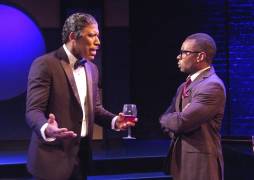 Fast forward a year and a half to a Harlem recording studio where Billy has taken Duke up on his invitation to “look me up when you’re in New York,” and before long “Swee’ Pea” and his mentor have begun a decades-long collaboration, one for which Duke claimed the lion’s share of the credit, though to be fair, Billy did get paid a salary (not royalties, mind you) that allowed him to live, if not in the actual lap of luxury, at least in its vicinity.
Fast forward a year and a half to a Harlem recording studio where Billy has taken Duke up on his invitation to “look me up when you’re in New York,” and before long “Swee’ Pea” and his mentor have begun a decades-long collaboration, one for which Duke claimed the lion’s share of the credit, though to be fair, Billy did get paid a salary (not royalties, mind you) that allowed him to live, if not in the actual lap of luxury, at least in its vicinity.
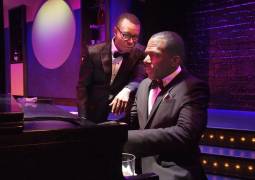 Enter a handsome and talented fellow musician named Aaron Bridgers (Gilbert Glenn Brown) and an unknown but stardom-bound singer named Lena Horne (Michole Briana White), both of whom are immediately smitten with Billy, and you’ve got quite the romantic triangle, though given Strayhorn’s natural predilection for the menfolk, it should come as no surprise which of the two ended up sharing his bed for the next dozen years.
Enter a handsome and talented fellow musician named Aaron Bridgers (Gilbert Glenn Brown) and an unknown but stardom-bound singer named Lena Horne (Michole Briana White), both of whom are immediately smitten with Billy, and you’ve got quite the romantic triangle, though given Strayhorn’s natural predilection for the menfolk, it should come as no surprise which of the two ended up sharing his bed for the next dozen years.
When Jazz Had The Blues recounts Billy Strayhorn’s personal and professional life from 1935 to 1955, focusing in particular on WWII years that have Billy and Lena USO-touring in Italy and Billy and Duke collaborating on the racially groundbreaking Broadway flop Beggar’s Holiday.
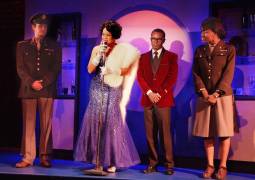 If there’s nothing at all in the above synopsis that can’t be googled in an instant, When Jazz Had The Blues adds up to much more than a quick Wikipedia read thanks to Eglash-Kosoff’s engrossing script, John Henry Davis’s incisive direction, and an absolutely sensational cast.
If there’s nothing at all in the above synopsis that can’t be googled in an instant, When Jazz Had The Blues adds up to much more than a quick Wikipedia read thanks to Eglash-Kosoff’s engrossing script, John Henry Davis’s incisive direction, and an absolutely sensational cast.
Factor in musical director/orchestrator Rahn Coleman and the production’s jazztastic six-piece band* backing up hits like “Take The ‘A’ Train,” “It Don’t Mean a Thing If It Ain’t Got that Swing,” “In a Sentimental Mood,” and “It’s Not What You Do But the Way You Do It” and you’ve got a musical biography unlike just about any you’ve seen.
Not that there isn’t enough in Billy’s story to fascinate even without musical interludes, including a same-sex romance virtually unheard of at its time (albeit not without its bumps), Billy’s years of struggle to assert his musical independence from the man to whom he owed his start, and a lifelong love for Lena that he was not genetically engineered to reciprocate in bed.
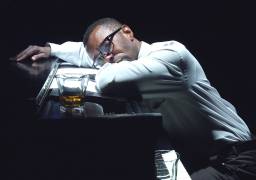 Whether crooning in the silkiest of pipes, or tickling the grand piano ivories with magic fingers, or digging deep into a man’s hopes, doubts, and fears, Lawson commands the stage as the slight-in-stature but tall-in-talent Billy, a star turn that both anchors When Jazz Had The Blues and allows others around him to shine.
Whether crooning in the silkiest of pipes, or tickling the grand piano ivories with magic fingers, or digging deep into a man’s hopes, doubts, and fears, Lawson commands the stage as the slight-in-stature but tall-in-talent Billy, a star turn that both anchors When Jazz Had The Blues and allows others around him to shine.
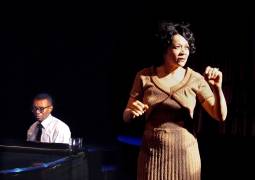 White is simply stunning as disc-and-screen star Horne, behind-the-scenes glimpses at her unfulfilled love for Billy (just wait till you hear White sing “Bill” in addition to “The Man I Love,” “Stormy Weather,” “The Lady Is a Tramp”), her mostly lost battles with racist Hollywood (Louis B. Mayer in particular), and her incipient civil rights activism proving among the evening’s most compelling moments.
White is simply stunning as disc-and-screen star Horne, behind-the-scenes glimpses at her unfulfilled love for Billy (just wait till you hear White sing “Bill” in addition to “The Man I Love,” “Stormy Weather,” “The Lady Is a Tramp”), her mostly lost battles with racist Hollywood (Louis B. Mayer in particular), and her incipient civil rights activism proving among the evening’s most compelling moments.
Holmes proves such a dead-ringer for Ellington that those who’ve seen the jazz legend captured on film may have to blink twice to believe it’s not Duke himself come back to life on the Matrix stage; Brown’s effortlessly masculine Aaron cuts so dashing a figure, it’s no wonder Billy found him impossible to resist; and Katherine Washington is all curvy sex appeal and sass as Duke’s longtime illicit love “Trixie.”
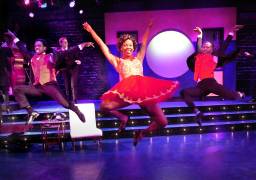 Ensemble members Darian Archie, Michael Covert, Keverlie Herron, Brad Light, and dance captain Chris Smith deliver one finely-defined cameo after another, with special snaps to Archie, Herron, and Smith for their dazzling execution of Cassie Crump’s high-energy choreography and to Covert’s exquisite tenor and Herron’s graceful moves to a “My Romance” performed entirely in silhouette. (A prerecorded Richard Tatum voices radio and nightclub announcers.)
Ensemble members Darian Archie, Michael Covert, Keverlie Herron, Brad Light, and dance captain Chris Smith deliver one finely-defined cameo after another, with special snaps to Archie, Herron, and Smith for their dazzling execution of Cassie Crump’s high-energy choreography and to Covert’s exquisite tenor and Herron’s graceful moves to a “My Romance” performed entirely in silhouette. (A prerecorded Richard Tatum voices radio and nightclub announcers.)
Leigh Allen lights Se Hyun Oh’s set (the picture of ‘30s/‘40s elegance), Michael Mullen’s costumes (one period dazzler after another), and Byron J. Batista’s hair and makeup to nuanced perfection, with Christopher Moscatiello and production sound engineer Gary Markowitz providing an expert sound mix throughout.
When Jazz Had The Blues is produced by Leigh Fortier. Tiffany Thomas is associate producer. Debbie Blount is production stage manager. Additional program credits are shared by Hallie Mayer (assistant director), Shen Heckel (assistant producer), and many more. Casting is by Michael Donovan, CSA.
History relegated Billy Strayhorn to the shadows behind superstars Duke Ellington and Lena Horne. When Jazz Had The Blues aims to rectify that by giving him his moment in the spotlight he so richly deserves. If you’re anything like me, you’ll rejoice that it does.
*Eric Butler, Coleman, Quentin Dennard, Michael Saucier, Stephan Terry, and Rickey Woodard
Matrix Theatre, 7657 Melrose Avenue, Los Angeles.
www.plays411.com/jazzblues
–Steven Stanley
November 26, 2016
Photos: Ed Krieger
Tags: Billy Strayhorn, Carole Eglash-Kosoff, Duke Ellington, Lena Horne, Los Angeles Theater Review, Matrix Theatre



 Since 2007, Steven Stanley's StageSceneLA.com has spotlighted the best in Southern California theater via reviews, interviews, and its annual StageSceneLA Scenies.
Since 2007, Steven Stanley's StageSceneLA.com has spotlighted the best in Southern California theater via reviews, interviews, and its annual StageSceneLA Scenies.







 COPYRIGHT 2025 STEVEN STANLEY :: DESIGN BY
COPYRIGHT 2025 STEVEN STANLEY :: DESIGN BY